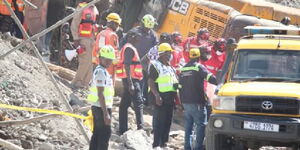With the world facing a shortage of ventilators, the duo of Paul Kariuki and Samuel Kairu have locally-made the machine using a wiper motor in a record time of four days.
Ventilators are one of the most sort after pieces of equipment in the world currently, due to the ongoing Coronavirus pandemic.
The duo from Thika saw an opportunity and grabbed it with both hands, embarking on a mission to create a locally assembled ventilator.
The two raised Ksh 98,000 from the public to build the prototype and used Ksh 86,000 in the project and plan to use the remaining Ksh12,000 to lobby for prototype testing and mobilization to start 3D printing services.
Paul who operated a cyber cafe which he closed due to the pandemic had to ask Samuel for fare in order to make the trip to Ruiru and start making the prototype.
The innovation is perfectly suited to be used around the country as it does not require electricity and relies on a battery for power.
Their ventilator comprises a wiper motor, a relay, switches, a piston, a crankshaft, a bulb, a bag that traps air, a reservoir and a car battery.
A ventilator is a machine that provides mechanical ventilation by moving breathable air into and out of the lungs, to deliver breaths to a patient who is physically unable to breathe.
In a video posted on Facebook, Paul explained how the ventilator works by pointing out to the various components, "The switch powers the wiper motor, as you can see there is a piston going down and pressing the bag.
"This is the inside bulb that illuminates the bag. The piston pushes a bag and it produces air, the volume of air is stable.
"The motor can be regulated and you can increase the speed as you wish, this is a three-speed motor, you can also put a timer, an intermittent timer which you can delay the air.
"We are trying to mimic breathing, we are yet to get approval from a doctor and we welcome to have it inspected."
The two raised Ksh 98,000 from the public to build the prototype and used Ksh 86,000 in the project and plan to use the remaining Ksh12,000 to lobby for prototype testing and mobilization to start 3D printing services.
An influential report from Imperial College London estimates that 30% of hospitalised Covid-19 patients are likely to require mechanical ventilation.
Paul explained that the shortage of ventilators made them come up with the innovation, "In fighting Covid-19, we have to be inventive because currently, the world is facing a shortage of ventilators.
"Before we get overwhelmed by the virus, we must make ventilators so this is the first locally assembled ventilator."
A ventilator's functionality makes one difficult to produce, in that they have to operate in an extremely reliable way in a high-stakes environment.
One of the ways to make them reliable is extensive testing, which could take up to two years of testing, for commercial manufacturers.
{"preview_thumbnail":"/files/styles/video_embed_wysiwyg_preview/public/video_thumbnails/x7t2os4.jpg?itok=sk9AT0uW","video_url":"","settings":{"responsive":1,"width":"854","height":"480","autoplay":0},"settings_summary":["Embedded Video (Responsive)."]}












